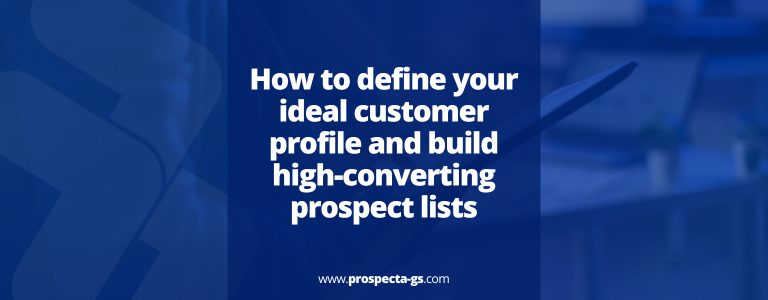Ideal customer profile: how to build prospect lists that convert
In B2B outbound prospecting, guesswork is expensive. Time spent chasing the wrong accounts leads to bloated pipelines, missed quotas, and high customer acquisition costs. The solution? Start with a laser-focused Ideal Customer Profile (ICP).
In this guide, you’ll learn how to define your ICP and build high-converting prospect lists that feed your sales pipeline with meetings that actually close.
What is an Ideal Customer Profile (ICP)?
An Ideal Customer Profile is a detailed description of the type of company that is most likely to benefit from your solution and generate the highest lifetime value. Unlike buyer personas, which focus on individuals, ICPs focus on organizations.
A well-defined ICP helps you:
Target companies that are more likely to convert.
Shorten your sales cycle.
Reduce churn by aligning expectations.
Improve SDR performance through precision targeting.
Why most prospecting fails without a defined ICP
Many B2B companies rely on volume instead of precision. As a result, SDRs waste time on low-fit leads that stall or never convert. A misaligned ICP causes:
Low email open/reply rates.
Poor show rates on meetings.
Sales teams blaming marketing, and vice versa.
In other words, your outbound performance is only as strong as your ICP.
Step-by-Step: How to define your Ideal Customer Profile
1. Analyze your best customers
Start by identifying the customers who love your product and generate high revenue with low churn.
Ask:
What is their industry and company size?
What technology do they use?
Where are they located?
What pain points do we solve for them?
Who was the internal champion during the sale?
This data gives you real-world insight into where your product resonates most.
2. Define firmographics and technographics
Firmographics (e.g., size, revenue, location) and technographics (e.g., tools, software, cloud infrastructure) give you objective filters for list building.
Examples of firmographic filters:
B2B SaaS companies with 50–500 employees
Revenue > $10M
US-based with global operations
Technographic indicators:
Uses Salesforce or HubSpot
Runs on AWS
Prior investment in outbound tools
3. Identify trigger events
Companies are more likely to buy at specific moments. Use trigger events to time your outreach for higher conversion.
Examples:
Recent funding
Executive hiring (e.g., new VP of Sales)
Product launch or expansion
Mergers and acquisitions
By tracking these signals, your SDR team can strike when urgency is highest.
4. Map buying committees
In complex B2B sales, there are often 5+ decision-makers involved. Identify the titles and departments that typically influence the deal.
For example:
CEO (budget holder)
VP of Sales (problem owner)
Sales Enablement Manager (user)
Procurement or Finance (gatekeeper)
This multi-threading strategy ensures you’re not relying on a single champion.
How to build a high-converting prospect list based on your ICP
Once your ICP is clear, list building becomes a science, not a guessing game.
1. Use multi-criteria filtering
Use tools and databases that allow advanced filtering based on:
Industry niche
Employee count
Technologies used
Recent hiring trends
Company growth indicators
Always cross-reference filters to ensure accuracy and fit.
2. Prioritize accounts with high intent
Not all ICP-fit accounts are actively looking. Prioritize those showing buying signals:
Engaged with similar tools
Searching for relevant keywords
Hiring SDRs or building a sales team
This allows your SDRs to focus on warm targets instead of cold lists.
3. Clean and enrich your data
Dirty data kills outbound. Before launching sequences, verify:
Email validity (avoid hard bounces)
Correct job titles
LinkedIn profile links
Phone numbers (where applicable)
Use enrichment tools or services like Prospecta to ensure accuracy and freshness.
Common mistakes to avoid
❌ ICP that’s too broad: “Any company with sales team” is not an ICP.
❌ Relying only on personas: Focusing on individual roles without company context reduces relevance.
❌ No feedback loop: Failing to review what accounts actually convert leads to outdated ICPs.
The role of outsourced SDRs in ICP execution
An outsourced SDR partner like Prospecta Global Solutions brings specialized expertise in:
Mapping and refining your ICP based on historical conversion data.
Building segmented, enriched prospect lists.
Executing outbound with show-rate SLAs to guarantee performance.
With an optimized ICP and a partner committed to predictable outcomes, your team gains time, focus, and results.
FAQ
What is the difference between ICP and buyer persona?
ICP focuses on the type of company you want to target. Buyer personas are about the people (roles and behaviors) within those companies.
How often should I update my ICP?
Review and adjust your ICP at least quarterly, or whenever your product, market, or strategy evolves.
Ready to turn your ICP into revenue?
Let Prospecta help you define, operationalize, and execute your Ideal Customer Profile strategy, then deliver meetings that actually close.
👉 Book a consultation now and discover how we generate qualified appointments with guaranteed performance.


